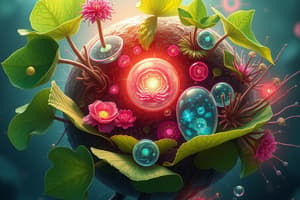Podcast
Questions and Answers
Photosynthesis is a catabolic process that breaks down organic compounds.
Photosynthesis is a catabolic process that breaks down organic compounds.
False (B)
Chlorophyll and carotenoids are photosensitive pigments that absorb light.
Chlorophyll and carotenoids are photosensitive pigments that absorb light.
True (A)
There is only one photosystem present in the thylakoid membranes.
There is only one photosystem present in the thylakoid membranes.
False (B)
Photosystem II is linked to an electron transport chain and sensitive to different wavelengths of light than photosystem I.
Photosystem II is linked to an electron transport chain and sensitive to different wavelengths of light than photosystem I.
The light-dependent reactions use light to synthesize ATP and oxidized NADP.
The light-dependent reactions use light to synthesize ATP and oxidized NADP.
Electrons in chlorophyll molecules in photosystem II are replaced by electrons from photolysis of water.
Electrons in chlorophyll molecules in photosystem II are replaced by electrons from photolysis of water.
Cyclic photophosphorylation is a process where only photosystem II is used.
Cyclic photophosphorylation is a process where only photosystem II is used.
Flashcards are hidden until you start studying
Study Notes
Photosynthesis: Light-Dependent Reactions and the Structure of Chloroplasts
- Photosynthesis involves a series of reactions that use light and are anabolic.
- Light is transduced, meaning it is changed from one type of energy to another, and is converted into chemical energy.
- Chlorophyll and carotenoids are photosensitive pigments that absorb light.
- Photosystems, which contain these pigments and electron transport chains, are fixed in thylakoid membranes for efficiency.
- There are two different photosystems, each linked to different electron transport chains and sensitive to different wavelengths of light.
- A photosystem consists of an antenna complex, which transfers energy to a reaction center molecule where light-dependent reactions begin.
- The light-dependent reactions use light to synthesize ATP and reduced NADP, which provide energy and hydrogen ions for the light-independent reactions.
- Electrons in chlorophyll molecules in photosystem II are excited by light, escape the molecule, and are replaced by electrons from photolysis of water.
- The excited electrons pass through an electron transport chain, losing energy and pumping protons into the thylakoid space, which leads to the chemiosmotic synthesis of ATP.
- Electrons in photosystem I are excited by light and pass through a second electron transport chain, ultimately forming reduced NADP.
- A photosynthetic unit is a collection of pigments, electron carriers, and ATP synthase that can carry out all the reactions in the light-dependent stage of photosynthesis.
- Cyclic photophosphorylation is a process where only photosystem I is used, and electrons lost from the chlorophyll molecule are returned to it, producing ATP when sugars cannot be synthesized due to a lack of carbon dioxide.
Studying That Suits You
Use AI to generate personalized quizzes and flashcards to suit your learning preferences.




